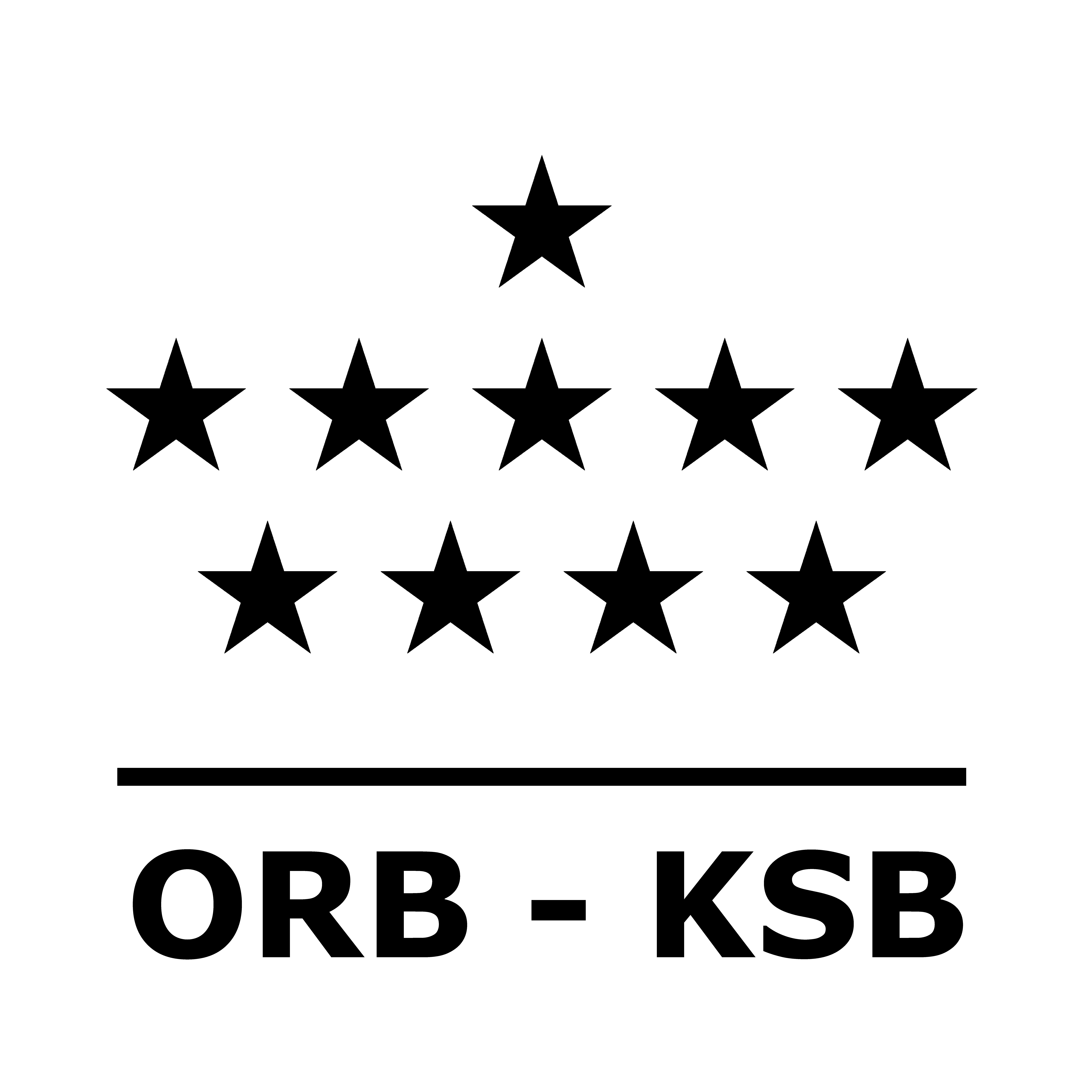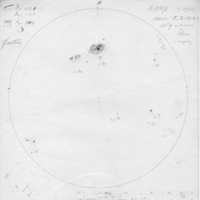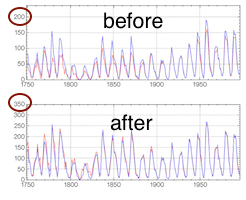NL: Het zonnevlekkengetal, het "langstlopende wetenschappelijk experiment" herbekeken
FR: Taches Solaires, la "plus longue étude scientifique toujours en cours" réexaminée
EN: The Sunspot Number, the "longest ongoing scientific experiment" revisited
Click for a larger image
Het zonnevlekkengetal, het "langstlopende wetenschappelijk experiment" herbekeken
Vorige week, tijdens de algemene samenkomst van de Internationale Unie voor Astronomie (IAU) in Honolulu (Hawaii), werd de standaardisatie van het zonnevlekkengetal publiek gemaakt. Deze data-reeks over een tijdspanne van meer dan 3 eeuwen is een sleutel om de evolutie van de Zon in kaart te brengen en wordt gebruikt in het onderzoek naar andere sterren en de impact van onze Zon op het leven op Aarde.
Het zonnevlekkengetal gaat terug tot Galileo Galilei die begin 17de eeuw zijn telescoop naar de Zon richtte en letterlijk vlekken op de Zon telde. Hierop volgden 4 eeuwen met zeer veel verschillende waarnemers en telescopen, en een lange geschiedenis om het getal te berekenen en de waarnemingen met elkaar in overeenstemming te brengen. Niet iedereen heeft immers een even sterke telescoop, even goede ogen en de telescopen zelf evolueerden mee met de tijd. Sinds 1981 is het Wereld Data Centrum, dat deel uitmaakt van de Koninklijke Sterrenwacht van België en nu wordt geleid door Dr. Frederic Clette, de officiële waakhond van het zonnevlekkengetal. Dagelijks worden nieuwe waarnemingen van de zonnevlekken van internationale netwerken van zowel professionelen als amateurs hier verzameld, verwerkt en opgeslagen in de zonnevlekken-databank die teruggaat tot het jaar 1700.
Gelijkaardig aan wat men doet bij de renovatie van een oud schilderij, heeft Dr. Clette samen met zijn internationale partners de berekeningsmethoden die op elk moment in de geschiedenis werden gebruikt, onder de loep genomen. Ze wisten te achterhalen welke veranderingen in de manier waarop de waarnemingen werden verwerkt, een ongewenst effect hadden op de data. De berekeningen werden herhaald en de verschillende reeksen van historische waarnemingen aan elkaar geplakt. Het team kwam zo tot een nieuwe gestandaardiseerde reeks van zonnevlekkengetallen, een huzaren-werk.
Het wetenschappelijk magazine Nature bestempelt dit als een 'hot topic' wegens de grote interesse voor de drijvende krachten achter ons klimaat. Het is ook opmerkelijk dat de reeks zonnevlekkengetallen, bekomen door een aanzienlijke bijdrage van amateurs en door eeuwenlang te investeren in waarnemingsmateriaal en mensen, een wetenschappelijke waarde heeft die vergelijkbaar is met zonnedata verkregen via immens grote (ruimte-)telescopen en korte termijn wetenschappelijke projecten. Hierdoor zijn de zonnevlekkendata uniek en hebben ze een groot wetenschappelijk belang.
Meer info
SILSO, Sunspot Index and Long-term Solar Observations, is het Werelddatacentrum voor de productie, opslagen en verspreiden van het Internationale Zonnevlekkengetal. Het is erkend door de internationale wetenschappelijke gemeenschap via de International Council for Science . SILSO maakt deel uit van de Koninklijke Sterrenwacht van Belgiëen wordt ondersteund door het Solar-Terrestrial Center of Excellence.
IAU persbericht en het Nature nieuwsitem.
Taches Solaires, la "plus longue étude scientifique toujours en cours" réexaminée
La semaine dernière, à l'assemblée générale de l'Union Astronomique Internationale (UAI) à Hawaï, la recalibration de la série temporelle des taches solaires a été annoncée. Cette série de taches solaires est la plus longue étude scientifique toujours en cours: c'est donc la clé pour l'étude de l'évolution du Soleil. Etant donné sa nature fondamentale, la série en question est utilisée fréquemment en astrophysique (pour l'évolution stellaire) et pour l'étude de l'impact à long-terme de l'évolution solaire sur la vie terrestre.
Le comptage des taches solaires a débuté avec l'invention des premiers télescopes à l'époque de Galilée et présente une histoire mouvementée, parsemée de nombreux observateurs, de différentes méthodes de calcul et calibrations. Depuis 1981, la production et la maintenance de la série se fait à l'Observatoire Royal de Belgique au World Data Center SILSO (WDC-SILSO), aujourd'hui dirigé par le Dr. Frédéric Clette. De nouvelles observations des taches arrivent tous les jours à Bruxelles depuis un réseau international composé d'observateurs professionnels et amateurs pour enrichir la série existante.
Comme pour la restauration d'un tableau, le Dr. Clette et ses partenaires internationaux ont étudié avec soin toutes les procédures appliquées précédemment pour maintenir la stabilité de cette série sur plusieurs siècles. En la comparant à des séries proches, ils ont identifié quels changements dans les procédures ou les observations ont eu des effets indésirables sur la série des taches solaires. En corrigeant ces effets et en mettant bout à bout les données de différentes périodes et différents observatoires ayant des propriétés différentes, ils sont arrivés à une nouvelle série, calibrée de manière cohérente sur toute sa longueur.
Selon le très connu magazine Nature cette recalibration est un " sujet brûlant " : étant donné l'énorme intérêt du public pour l'évolution du Soleil et le Climat, cette dernière risque fort d'être passée au microscope. Il est tout à fait exceptionnel que cette série de taches solaires, qui nécessite un important investissement long-terme et repose en grande partie sur des observateurs amateurs, ait maintenu sa position unique dans une ère où les télescopes spatiaux et les financements à court-terme dominent.
Plus d'informations
SILSO, Sunspot Index and Long-term Solar Observations, est le centre mondial de production, préservation et distribution du nombre international de taches solaires, reconnu par le conseil international pour les Sciences. Il est situé à l'Observatoire Royal de Belgique. Les activités du centre SILSO sont co-financées par le Solar Terrestrial Center of Excellence .
IAU communiqué de presse et les nouvelles du magazine Nature.
The Sunspot Number, the "longest ongoing scientific experiment" revisited
Last week, at the General Assembly of the International Astronomical Union in Honolulu (Hawaii), the standardization of the sunspot number was publicly announced. IAU called the sunspot number the "longest ongoing scientific experiment" and this dataset is therefore the key to track the evolution of the Sun. Given its fundamental nature, the sunspot number series is broadly used in astrophysics (stellar evolution) and the long-term impact of solar evolution on life on Earth.
Tracking the sunspot number stretches back to the first telescopes used by Galileo Galilei and has had over the last four centuries a lively history of varying observers, calculation procedures and calibration decisions. Since 1981, the production and the maintenance of the sunspot number is managed at the Royal Observatory of Belgium by the World Data Center, now led by Dr. Frederic Clette. New sunspot observations arrive in Brussels from an international network of both professionals and amateur observers, to continuously extend the sunspot number series.
As with the renovation of an old painting, Dr. Clette and his international partners carefully studied all efforts and procedures that had been previously applied to maintain stability over centuries. By comparing with related data sets, they identified which of the past procedural or observational changes had inappropriate effects on the sunspot number. Removing these and stitching together data from periods in history and from different observatories, they arrived at a new, more coherently standardized sunspot number data set.
The well reputed scientific magazine Nature called this a 'hot topic' which, given the intense public interest in solar forcing and climate, is likely to be carefully scrutinized. It is remarkable that the sunspot number data series, with a particular need for long-term investment and based partially on amateur observations, has maintained its unique position in this era of giant space telescopes and short-term project funding of science.
Links to more Information
SILSO, Sunspot Index and Long-term Solar Observations, is the World Data Center for the production, preservation and dissemination of the international sunspot number, as recognized by International Council for Science . It is hosted at the Royal Observatory of Belgium . The activities of SILSO are supported by the Solar Terrestrial Center of Excellence .
IAU press release and the Nature News item .
 |
 |
 |







